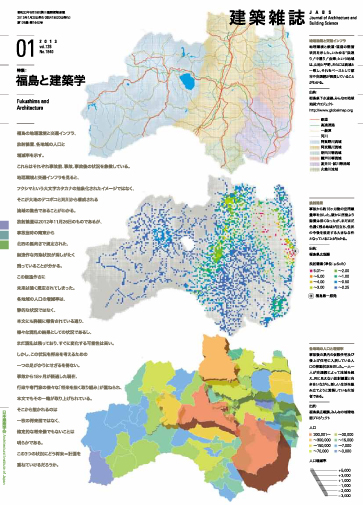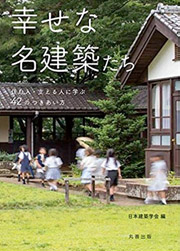本文PDFの閲覧につきましては、こちらでご確認ください。

2013-1月号 JANUARY
特集= 福島と建築学
Fukushima and Architecture
特集前言 建築学はいかに福島の閉塞を開きうるか
福島第一原子力発電所の事故から2年近くが経過する。その間、実に多くの課題が現れ、連鎖し、解決されぬまま山積し、舵取りを阻んでいる。この間、建築学からの問題提起、正確な調査研究、具体的な行動は、残念なことに決して多いとは言えない。そのことは、岩手や宮城の津波被災地に多くの大学研究室や専門家のサポートが入っていることに比せば、歴然としているだろう。また、ジャーナリストや思想家・歴史学者・社会学者らによる原発事故関連の書籍や雑誌記事は次々に世に送り出され、日本の社会・経済・政治と科学・技術のあり方の問い直しを迫っているのに対して、建築分野では福島の問題にその専門性をどう発揮できるのか、具体的なイメージは描けていない。『建築雑誌』においても、連載記事での仮住まいのレポートをのぞけば、本号が初めて原発被災地を正面から取り上げる。
建築分野の議論が少ない背景には、原発事故の極めて特殊な状況がある。原子力発電所はいまだ安定せず、政府の方針のブレも少なくない。放射性物質の汚染という事態に対して、現地調査すらままならない。土地があって初めて成立するのが建築であるが、広大な土地が、長時間にわたり目に見えない汚染で宙吊りになる状況を前に、建築学は立ちすくんできた。
だからこそ、本号では特集タイトルを「福島と建築学」とした。
繰り返すが、まもなく2年である。復興を困難にしている諸問題は、そのほとんどが起きてしまっているだろう。そこに「建築学」の知恵が求められている。具体的な展望は描けるはずであるし、描くべきであろう。
本特集の企画にあたって、いくつかの「議論しないこと」を決めた。①電力、エネルギー問題、②原発立地問題、③原発廃止問題、④原発建屋問題、⑤国土論、⑥風評被害、である。いずれも重要な視点であり、そこから複眼的に福島に迫ることにも意義があると考えたが、紙幅が限られるなかで、本特集は被災地の復興への展望にテーマを絞り込むこととした。
編集方針は二つである。第一に、原発事故後の15万人以上にもおよぶ避難の諸状況をできるだけ正確に描き出し、的確な論点の把握につとめること。第二に、抽象的な議論に陥ることなく、少しでも現実性の高い福島復興の可能性を、建築学の知恵と技術との関連において描き出すこと、である。
第1部「長期避難とはなんだったのか、建築学的課題の総括と展望」では、原発被災地の避難状況、応急的住宅対策、長期避難を受け止める建築ストックの活用、家族やコミュニティの分裂といった諸問題について記事を寄せていただいている。いずれも時間と労力を費やした調査・実践なしには描き出せない内容ばかりである。座談会ではこれら長期避難を前提とした計画論の諸条件について包括的な討議を行い、論点を抽出した。
第1部と第2部の間には、福島原発事故災害について考えるための歴史的参照項として、公害病、産廃問題、火山災害、チェルノブイリをとりあげた年表を掲載した。
「復興を支える建築学」と題した第2部では、福島県における復興計画まちづくりの概要と課題、復興課題の地域特性を把握したうえで、「福島の復興」を議論した。県の復興計画策定・調整あるいは個別地域の復興支援に携わる専門家に加えて、直接には被災地にかかわっていない諸分野の若手専門家をメンバーに、今後に向けた可能性ある提案を示していただくことを企画したものである。まず現地視察を踏まえた座談会を郡山で行ったが、参加の適わなかった方々には東京に集まっていただき、郡山での討議内容の報告を受けて討議を行った。後日、参加メンバーから提出いただいた提案メモをあわせて記事としている。
つづいて福島の復興を支える建築的技術を可能なかぎり網羅した。生活環境の除染、原子力発電所の建築物、中期仮設住宅と二地域居住、復興シナリオの検討・共有手法、リスク・コミュニケーション、子どもたちの遊ぶ環境づくり、である。
なお、本特集では、鈴木浩・浦部智義・芳賀沼整の三氏に企画段階から協力いただいた。記して謝意としたい。
会誌編集委員会
本号編集担当:饗庭伸(首都大学東京)・近藤卓(近藤卓デザイン事務所)
[目次]
| 000 | 連載 再建への意志:図面のなかの都市復興 阪神間復興都市計画地域地区図/中野茂夫 |
| 002 | 年頭所感 住みやすく親しまれ、長く多くの人々に尊敬される建築とまち/和田章 |
| 004 | 連載 東日本大震災|連続ルポ1|動き出す被災地 岩手県大槌町・町方地区の復興計画について/中井祐 |
| 006 | 連載 東日本大震災|連続ルポ2|仮すまいの姿 民間による恒久住宅建設の可能性と課題/後藤治 + 篠沢健太 + 豊沢幸四郎 |
特集 福島と建築学
| 008 | 特集前言 建築学はいかに福島の閉塞を開きうるか |
第1部 長期避難とはなんだったのか、建築学的課題の総括と展望
| 010 | 福島の地域構造/浦部智義 + 芳賀沼整 |
| 012 | 避難の実態とその考察から見る今後/浦部智義 + 芳賀沼整 |
| 015 | 福島県はどのように応急的住宅対策を進めてきたか/野内忠宏 |
| 017 | 長期避難と建築ストックの活用に関する問題構成/佐々木龍郎 + 新堀学 |
| 019 | 福島第一原発事故からの避難とコミュニティの再生/高木竜輔 + 山下祐介 |
| 021 | 座談会 長期避難期からの計画論 浦部智義 × 小泉秀樹 × 佐々木孝男 × 定行まり子 × 芳賀沼整 |
| 028 | 災害・公害・事故からの復興の年表/首都大学東京饗庭伸研究室 |
第2部 復興を支える建築学
| 030 | 福島県における復興計画まちづくりの課題/山川充夫 + 吉田樹 |
| 036 | 福島復興、三つのエリアのパラダイム/柴﨑恭秀 |
| 038 | 座談会 座談会 福島の復興 糸長浩司|吉良森子|鈴木浩|長谷川浩己|藤原徹平|山崎亮 |
| 選択肢を支える建築技術オールレビュー |
| 051 | 生活環境の除染/中山真一 |
| 053 | 原子力発電所の建築物/梅木芳人 |
| 055 | 二地域居住と中期仮設住宅/滑田崇志 |
| 056 | 復興シナリオの検討・共有手法 ─福島県浪江町の復興計画の検討に際して/白木里恵子 + 志村秀明 |
| 057 | 放射線リスクをめぐるコミュニケーション/村山武彦 |
| 058 | 「遊ぶ環境づくり」を模索する建築/菅博嗣 |
| 059 | 編集後記 近藤卓 + 饗庭伸 |
| 059 | 次号予告 2013年2月号|特集:リスクコミュニケーション─3.11以後の変質と波及 |
| 060 | 特集を読んで 2012年11月号|特集:トーキョー・アーバニズム ─駆動力、リスク、ライフスケープ 東京は都市のモデルではない/橋爪紳也 目配りの良い特集だけれども....../八束はじめ |
| 061 | 連載 建築の争点 「農家」と「町家」/大場修 |
| 062 | 連載 ケンチク脳の育て方 体感・実験・考察を通じて育む「初年次構造力学教育」/石川孝重 + 平田京子 |
| 063 | 連載 ケンチク脳の活かし方 楽譜を視覚化─舞台で生きる空間デザイン/田尾下哲 |
| 064 | 連載 地域いろいろ・多様な日本 蝦夷地漁場集落の発展と衰退─コタンベツ集落の今昔/外崎由香 |
Preface to the Special Issue: How Can Architecture Open Fukushima's Blockage?
Nearly two years have passed since the Fukushima No.1 Nuclear Power Plant accident. In that period, really many issues have appeared, interlocked, piled up unsolved, and blocked steering. Meanwhile, regrettably, we can never say that architecture has provided much in terms of suggested issues, accurate examinations and studies, or concrete action. This is obvious in comparison with the many university studies and experts who have come and supported the tsunami-devastated areas in Iwate and Miyagi. Also books and magazine articles related to nuclear accidents have appeared in this world one after another, from journalists, thinkers, historians, and sociologists, urging a re-asking of how society, economics, politics, and science and technology should be; by comparison, the architectural field has not been able to draw a concrete image of how its specialty can be put forth for Fukushima's problems. Even in JABS, this issue is the first to pick up the nuclear-devastated area from the front, except for the serial report on temporary housing.
In the background of the architectural field's few arguments, there are extremely particular circumstances in the nuclear accident. The nuclear power plant is still not stable, and there are not a few vacillations of governmental principles. In this case of radioactive contamination, even field investigation cannot be done easily. And although architecture happens only when there is land, architecture has become paralyzed before the situation of immense land long pending because of invisible contamination.
Therefore, we titled this issue's feature Fukushima and Architecture.
Again, it will soon be two years, and most of the problems that make recovery difficult have already occurred. That's where the wisdom of architecture is sought. A concrete view could and should be drawn.
In planning this feature, we decided not to argue about some issues: electricity and energy, power plant location, power plant abolition, reactor buildings, theories of national land, and rumor damage. They are all important viewpoints, and although we thought it meaningful to approach Fukushima with such a "compound eye," limited space requires that this feature focus on themes with a view toward recovery of the devastated areas.
There are two editorial policies: First, picture as correctly as possible the evacuation circumstances of more than 150,000 people after the power plant accident and try to grasp the exact points of contention. Second, avoid falling into abstract argument, but, for Fukushima's recovery, picture possibilities that are even a little more practical in relation to the wisdom and techniques of architecture.
Part 1, "What Long-Term Evacuation Was - A Summary and Outlook of Architectural Subjects," presents articles about problems such as evacuation circumstances in nuclear plant disaster areas, first-aid temporary-housing measures, applications of architectural stock for long-term evacuation, and splits in families and communities. The content of each article could not have been written without time and effort spent in examination and practice. The round tables present comprehensive discussions about the conditions of planning theory supposing these long-term evacuations, and points of dispute are extracted.
Inserted between part 1 and part 2 is a chronology that takes pollution diseases, industrial-waste issues, volcanic disasters, and Chernobyl as historical reference items.
In part 2, titled "Architecture That Supports Recovery," Fukushima's recovery is discussed after grasping the outline and issues of recovery plans and town development, and the local characteristics of recovery issues. It is designed so that, in addition to experts who work for a prefecture's creation and adjustment or the recovery support of individual regions, young experts from various fields who are not directly involved in disaster areas are also members and make possible suggestions for the future. First, the round table based on field inspection was held in Koriyama, and then people who could not participate gathered in Tokyo for discussions based on reports from the Koriyama round table. Days later, we conflated suggestion memos from members and wrote the article.
Next, as much as possible we covered architectural techniques that support Fukushima's recovery: decontamination of living environments, structures at nuclear power plants, mid- to long-term temporary living and bilocal living, risk communication, recovery-scenario studies and sharing techniques, and creating environments for kids' play.
For this feature, Hiroshi Suzuki, Tomoyoshi Urabe, and Sei Haganuma have cooperated from the planning stages, and we thank them.
Editorial Board
This issue has been edited by Shin Aiba (Tokyo Metropolitan University) and Taku Kondo (Taku Kondo Design, Inc.).
[Contents]
| 000 | [Series] The Resolve to Rebuilding: City Reconstruction in Blueprint Recovery City-Planning Map for the Zoning District between Osaka and Kobe / Shigeo Nakano |
| 002 | [New Year's Greetings] Shape a better architecture and a better city many people will respect in many years / Akira Wada |
| 004 | [Series] Great East Japan Earthquake Serial Report 1 Devastated Areas Have Just Started to Stir Concerning the Recovery Plans in Machikata District, Otsuchicho, Iwate / Yu Nakai |
| 006 | [Series] Great East Japan Earthquake Serial Report 2 Life in Temporary Housing Possibility and Issue of the Permanent Housing Construction by Private Sector / Osamu Goto + Kenta Shinozawa + Koshiro Toyosawa |
Special Feature
Fukushima and Architecture
| 008 | [Preface to the Special Issue] How Can Architecture Open Fukushima's Blockage? |
Part1 What Long-Term Evacuation Was ─A Summary and Outlook of Architectural Subjects
| 010 | Fukushima' s Regional Structure / Tomoyoshi Urabe + Sei Haganuma |
| 012 | The Future Reading from the Actual Situation and Consideration of Refuge / Tomoyoshi Urabe + Sei Haganuma |
| 015 | How did Fukushima Prefecture Advance the Temporary Housing Policy / Tadahiro Nouchi |
| 017 | The Structure of Problems Concerning Long-Term Evacuation and the Application of Architectural Stock / Tatsuro Sasaki + Manabu Shinbori |
| 019 | Evacuee from the Fukushima Nuclear Plant Accident and Reconstruction of Community / Ryosuke Takaki + Yusuke Yamashita |
| 021 | [Discussion] A Theory of Planning After the Period of Long-Term Evacuations Tomoyoshi Urabe × Hideki Koizumi × Takao Sasaki × Mariko Sadayuki × Sei Haganuma |
| 028 | A Chronology of Recoveries from Disasters, Pollution, and Accidents / Tokyo Metropolitan University Shin Aiba Laboratory |
Part2 Architecture That Supports Recovery
| 030 | Issues of Revitalization Plan and Town Development in Fukushima / Mitsuo Yamakawa + Itsuki Yoshida |
| 036 | Three Paradigms of Revitalization in Fukushima / Yasuhide Shibasaki |
| 038 | [Discussion] Round Tables─Fukushima' s Recovery Koji Itonaga|Moriko Kira|Hiroshi Suzuki|Hiroki Hasegawa|Teppei Fujiwara|Ryo Yamazaki |
| Reviews of Architectural Techniques That Support Options |
| 051 | Decontamination of Radioactive Contaminants of Living Environments / Shinichi Nakayama |
| 053 | Structures at Nuclear Power Plant Site / Yoshito Umeki |
| 055 | Bilocal Living and Midterm Temporary Housing / Takashi Nameda |
| 056 | Recovery-Scenario Study and Sharing Techniques ─From a Study of Recovery Planning in Namiemachi, Fukushima / Rieko Shiraki + Hideaki Shimura |
| 057 | Radiation Risk and Communication / Takehiko Murayama |
| 058 | Architecture Searching to Create Environments for Play / Hirotsugu Suga |
| 059 | [Editor's Postscripts] Taku Kondo + Shin Aiba |
| 059 | [Previews of Coming Issues] 2013, February|Risk Communication ─ Changes and Repercussions After 3.11 |
| 060 | [[Reviews of Previous Issue] 2012, November|Tokyo Urbanism─ Driving Forces, Risks, and Lifescape Tokyo Is Not a Model City|Shinya Hashizume An Observant Feature, but...|Hajime Yatsuka |
| 061 | [Series] Issues in Architecture Farmhouses and Town Houses / Osamu Oba |
| 062 | [Series] Cultivating Versatile Architects Raising First-Year Education in Structural Mechanics through Sensations, Experiments, and Examinations / Takashige Ishikawa + Kyoko Hirata |
| 063 | [Series] Architects Branch Out Making Scores Visible ─Spatial Design a Highlight on Stage / Tetsu Taoshita |
| 064 | [Series] Local Identities: Diverse Japan Development and Decline of a Fishing Village in Ezo ─The Present and Past of Kotanbetsu Village / Yuka Tonozaki |




 『幸せな名建築たち 住む人・支える人に学ぶ42のつきあい方』
『幸せな名建築たち 住む人・支える人に学ぶ42のつきあい方』





